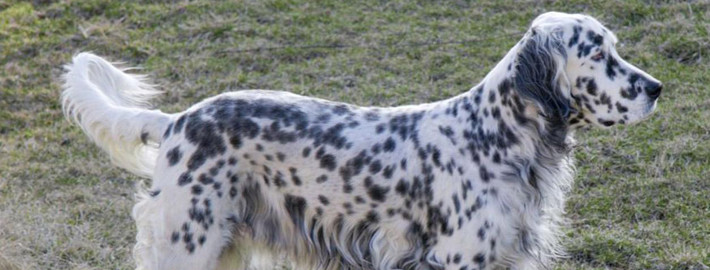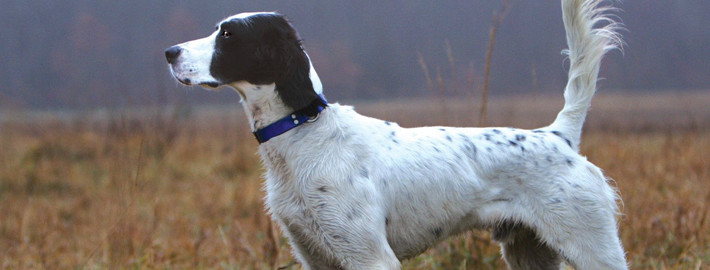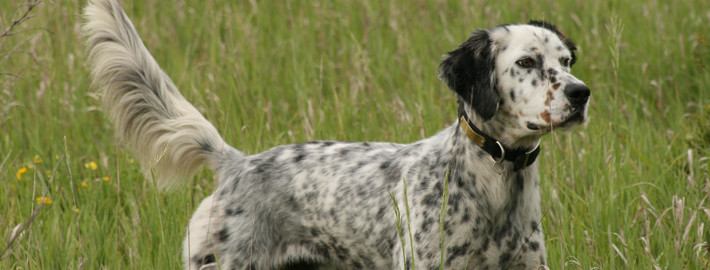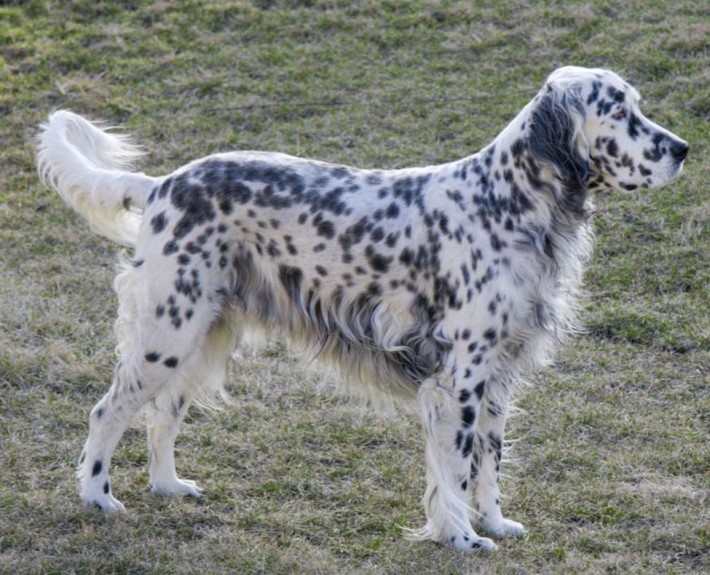What makes the English Setter Unique?
The English setter is an elegant and athletic hunting dog with the ability to run tirelessly at a good pace. Its trot is ground-covering and effortless, with the head held proudly and a lively tail. The coat is flat, with feathering on the ears, underside, backs of legs, underside of thighs, and tail. Its markings are distinctive, consisting of flecks of color, sometimes with patches, on a white background. The combination of good looks and hunting ability make the English setter a perfect gentleman’s hunting companion. The Laveracks tend to be larger, carry more feathering, often have deeper muzzles and usually hold their tails nearly level when on point. The Llewellins tend to be smaller and faster, with less coat and often larger patches of color. They tend to hold their tails straight up when on point. Bred to cover a lot of area when hunting, the English setter is a lively dog that loves to hunt and run. This is especially true of dogs from field lines. If not given sufficient exercise, they can be overly lively inside. With daily exertion, however, they are calm and tractable house dogs. Those from conformation lines are particularly laid-back and gentle and excel with children and less active adults. This is an amiable, easygoing breed that gets along well with children, strangers and other dogs.
Page Contents
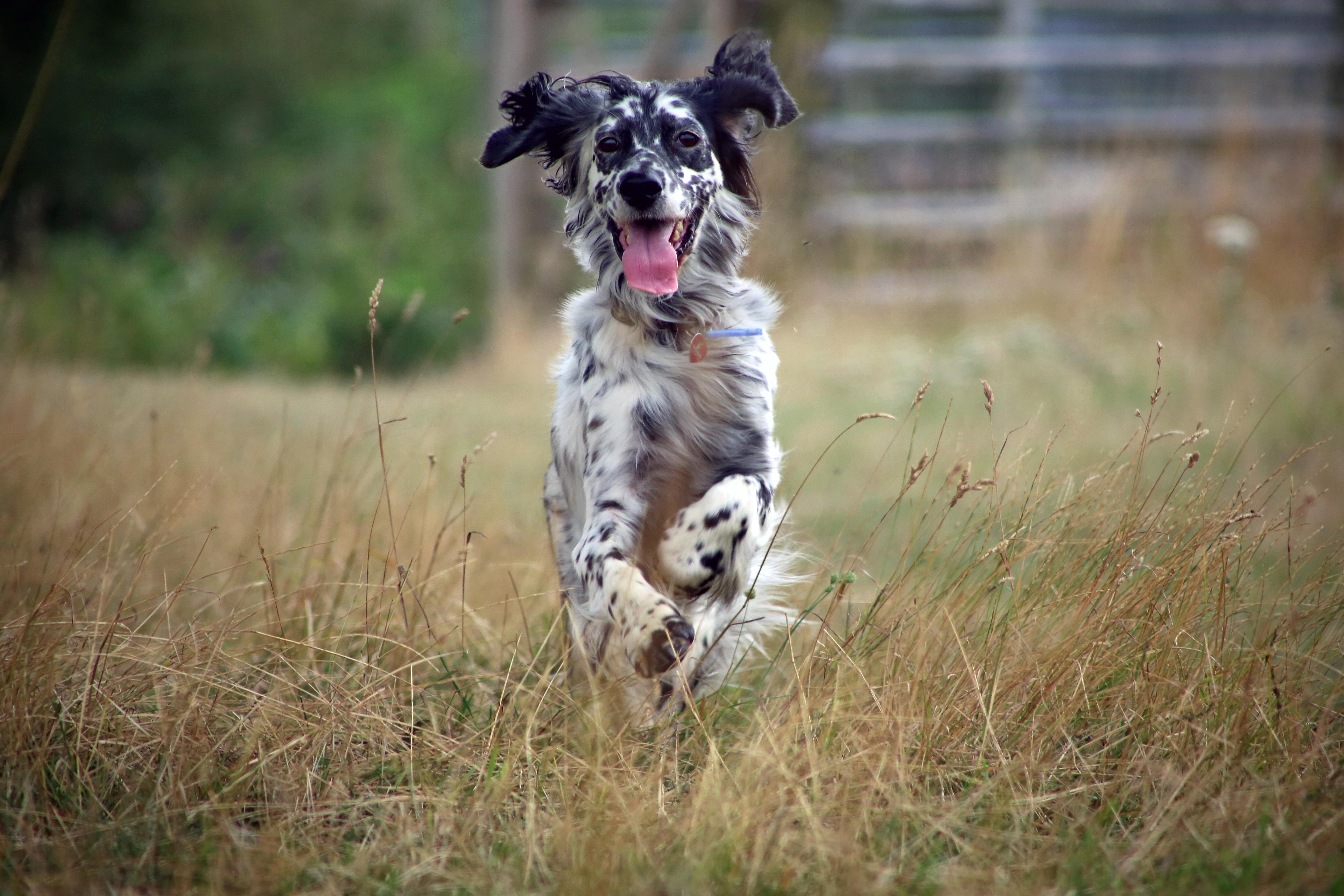
SnapShot
| Size: | Males – 61 to 69 cm (24 to 27 inches) Females – 58 to 66 cm (23 to 26 inches) |
| Weight: | Males – 25 to 36 kg (55.1 to 79.4 pounds) Females – 20 to 32 kg (44.1 to 70.5 pounds) |
| Origin: | England |
| Life Span: | 10 to 12 years |
| Colour: | Orange Belton, Lemon Belton, Liver Belton, Tri-color, Blue Belton |
| Litter Size: | 6 to 8 puppies |
Is the English Setter Right For You?
The English setter is an elegant and athletic hunting dog with the ability to run tirelessly at a good pace. Its trot is ground-covering and effortless, with the head held proudly and a lively tail. The coat is flat, with feathering on the ears, underside, backs of legs, underside of thighs, and tail. Its markings are distinctive, consisting of flecks of color, sometimes with patches, on a white background. This is especially true of dogs from field lines. If not given sufficient exercise, they can be overly lively inside. With daily exertion, however, they are calm and tractable house dogs. Those from conformation lines are particularly laid-back and gentle and excel with children and less active adults.
In 5 Words
- Strong Willed
- Gentle
- Energetic
- People-Oriented
- Mischievous
Characteristics
Learn About the English Setter
Description
This glamorous and elegant breed is both symmetrical and of substantial build. They are the epitome of strength, grace and stamina. Their long, flat coats are silky and well feathered. They have a free, graceful action that suggests speed and endurance. The coat is flat with light feathering of long length or short length depending on the type. The bench or show type has a long, flowing coat that requires regular grooming. The English Setter is a beautiful, elegant, and symmetrical gun dog , ideally an equal mix of endurance, athleticism, grace, and style.
Short History of the English Setter
The origin of the English Setter lies in England. The English Setter was originally bred to set or point upland game birds. From the best available information, it appears that the English Setter was a trained bird dog in England more than 400 years ago. There is evidence that the English Setter originated in crosses of the Spanish Pointer, large Water Spaniel, and English Springer Spaniel, which combined to produce an excellent bird dog with a high degree of proficiency in finding and pointing game in open country.
The English Setter is one of the oldest breeds of hunting dogs, with a history that traces back as early as the 14th century. By the 16th century there were three distinct Setters. English Setter is likely descended from crossbreeding between the Spanish Pointer, Springer Spaniel, and other water spaniels.
Temperament
This breed’s standard temperament is best described as a “Gentleman by Nature”. However, it can also be strong-willed and mischievous. This breed’s standard temperament can be described as friendly and good natured. Despite its happy-go-lucky attitude, it is very strong-willed, mischievous, and outgoing. They love to be around their families, especially children, since they love the attention an energetic child can provide.
Caring for Your English Setter
General Health
Setters have a few genetic problems that may occasionally occur. Canine hip dysplasia, elbow dysplasia, congenital deafness (affecting 12.4% of the specimens of the breed.
Not all Setters will get any or all of these diseases, but it’s important to be aware of them if you’re considering this breed
Grooming & Bathing
The long coat needs regular brushing every two or three days. The white coat may be difficult to keep gleaming in some areas. Some clipping and trimming every month or two is advisable for optimal good looks.
Exercise & Training
The English setter needs a lot of exercise every day, requiring at least an hour of hard exertion. It does best when it can live inside and play outside.

